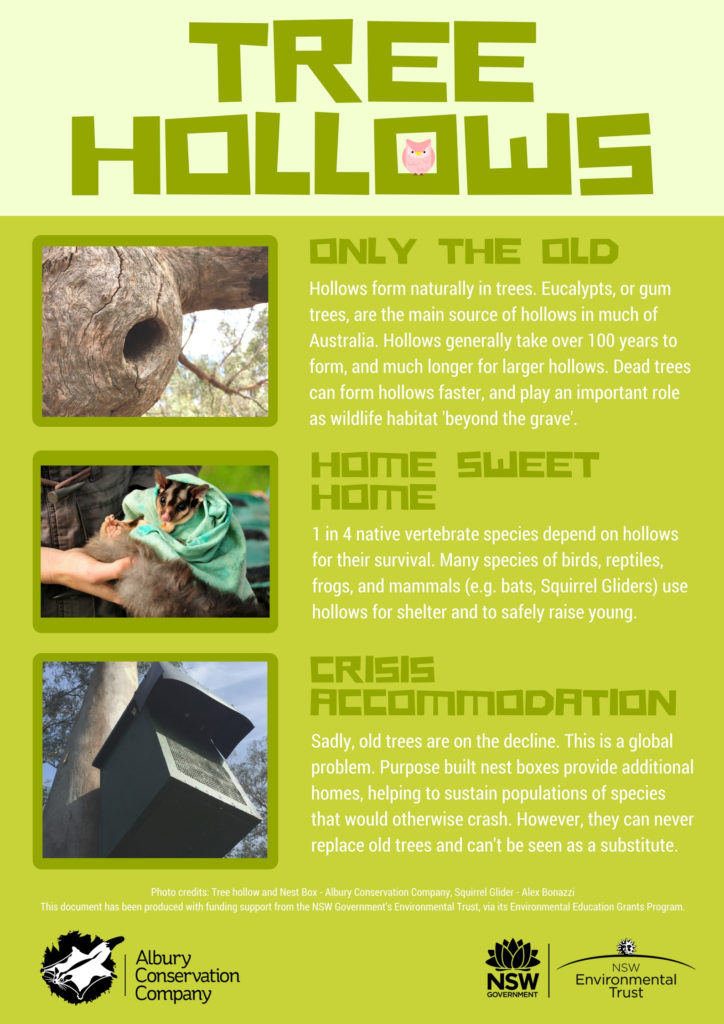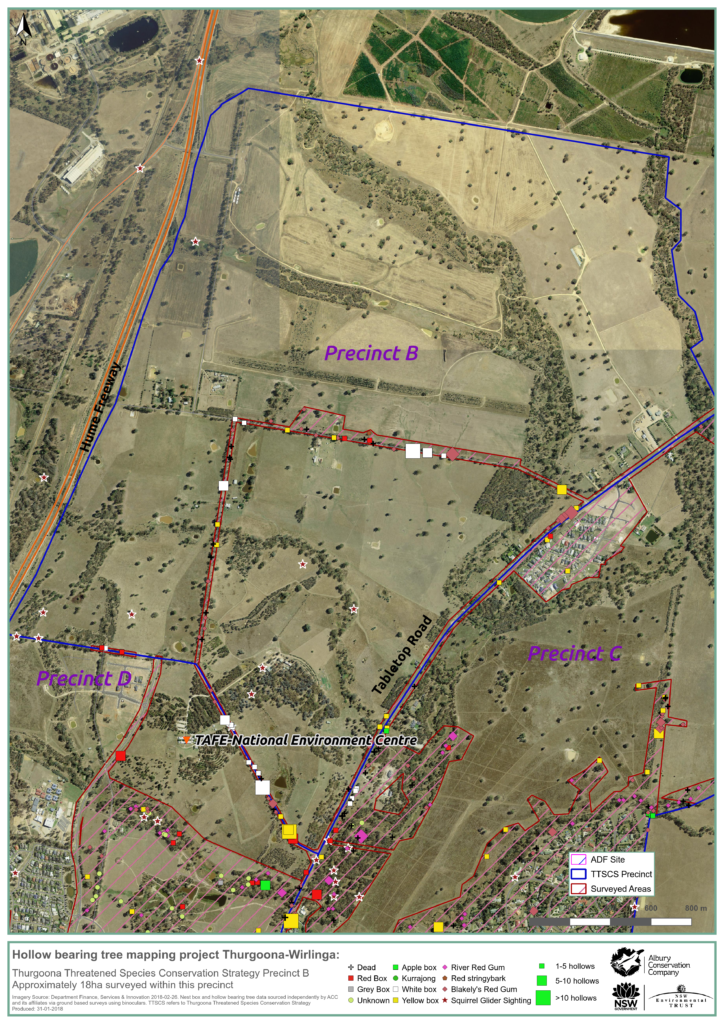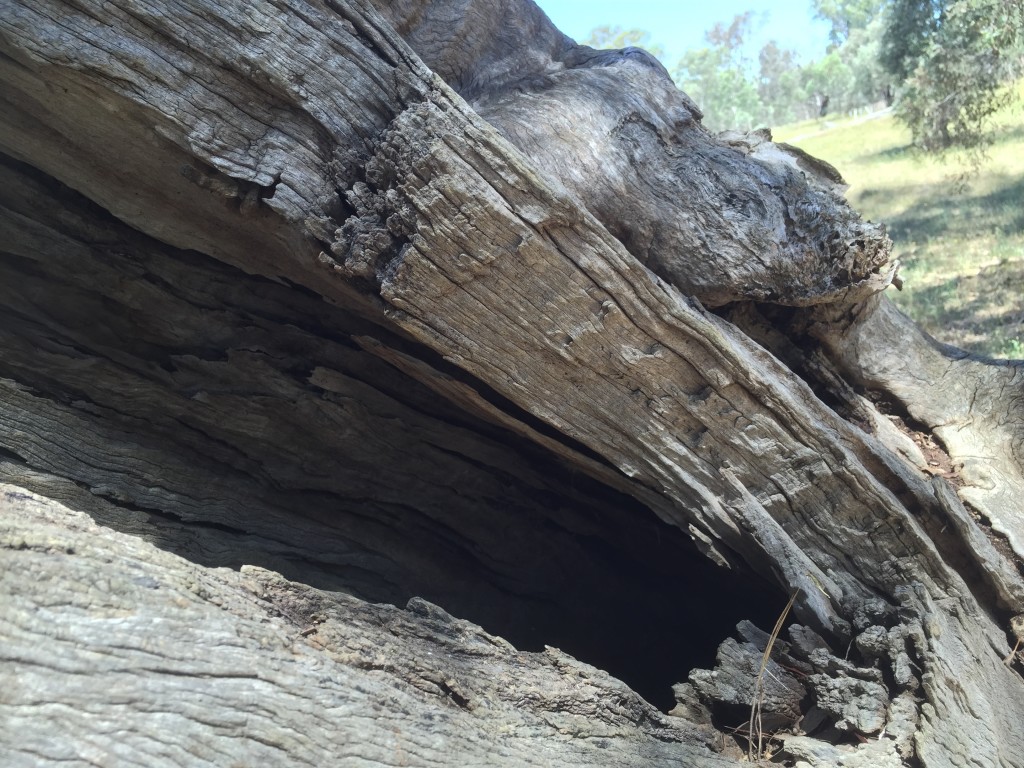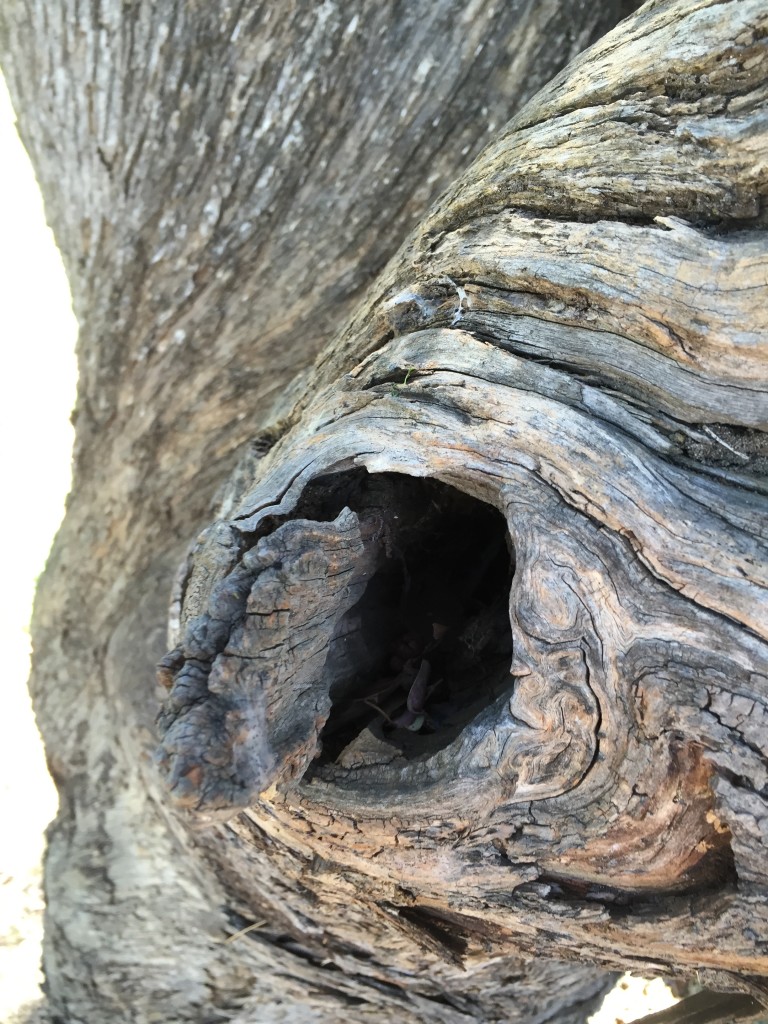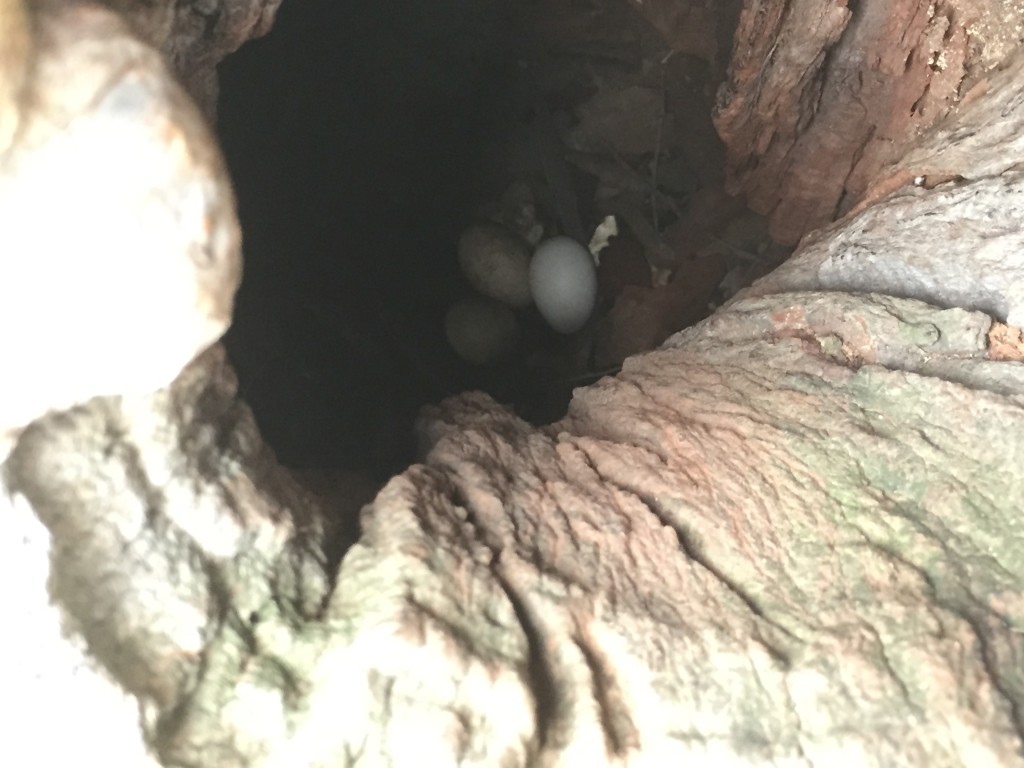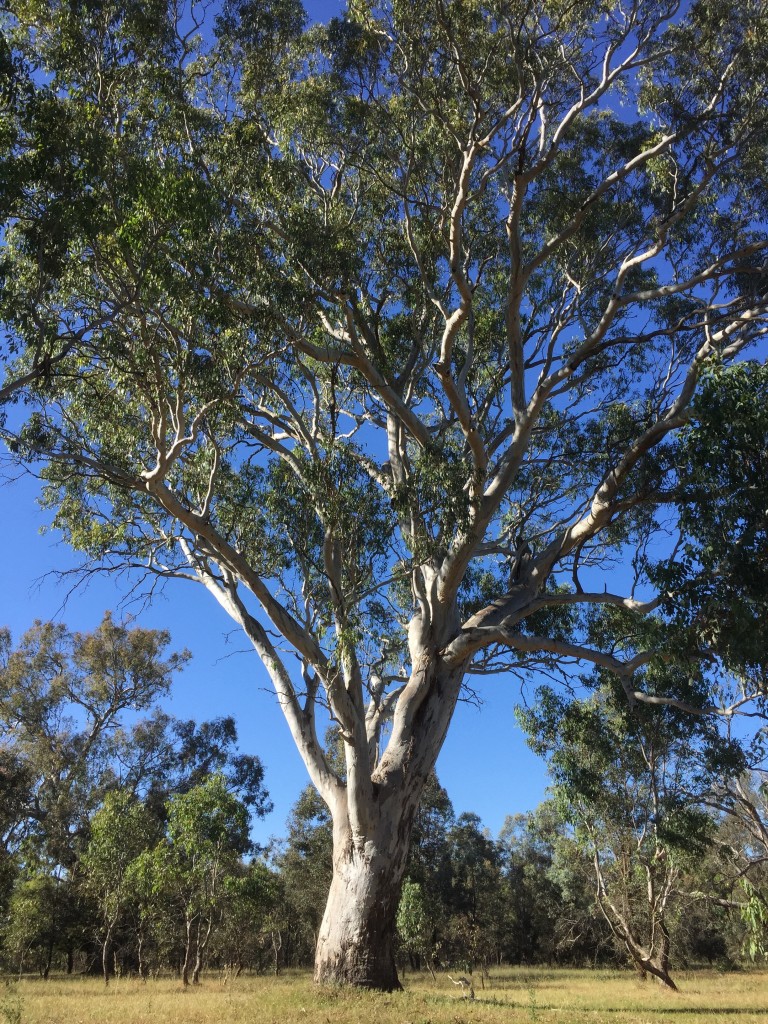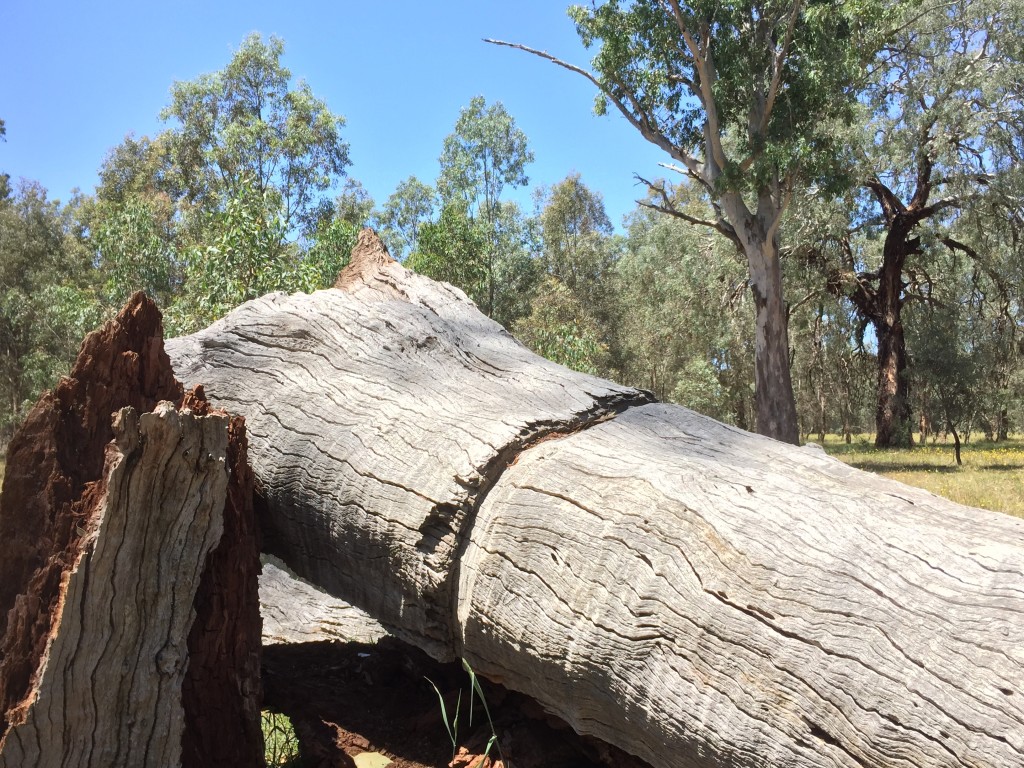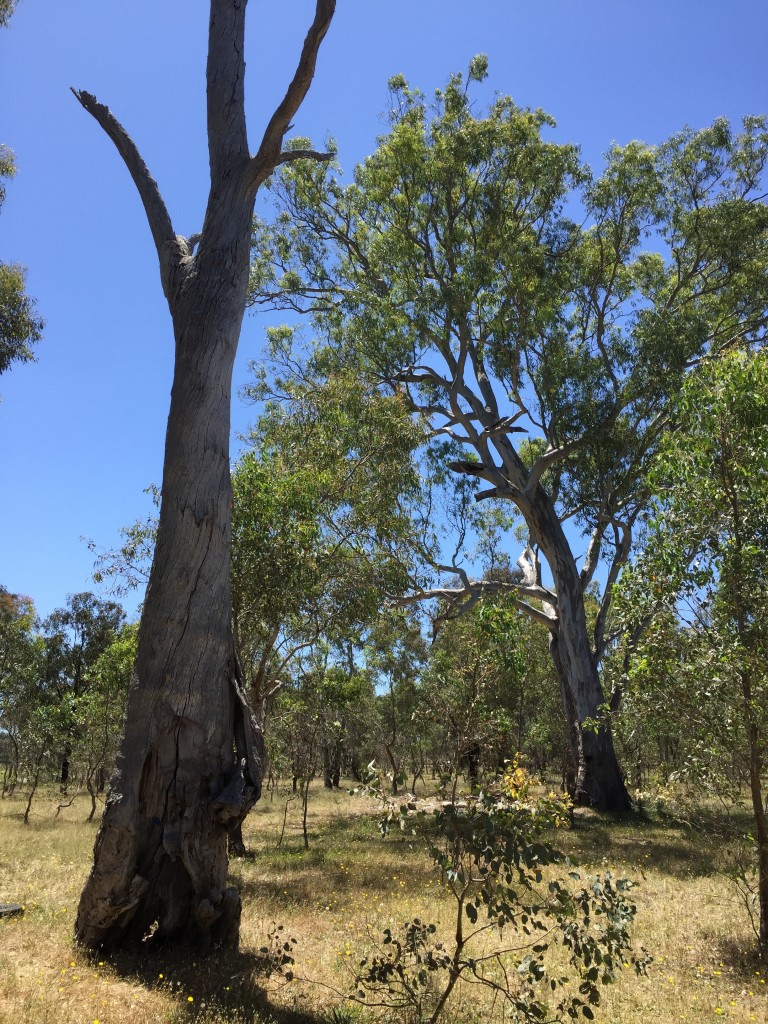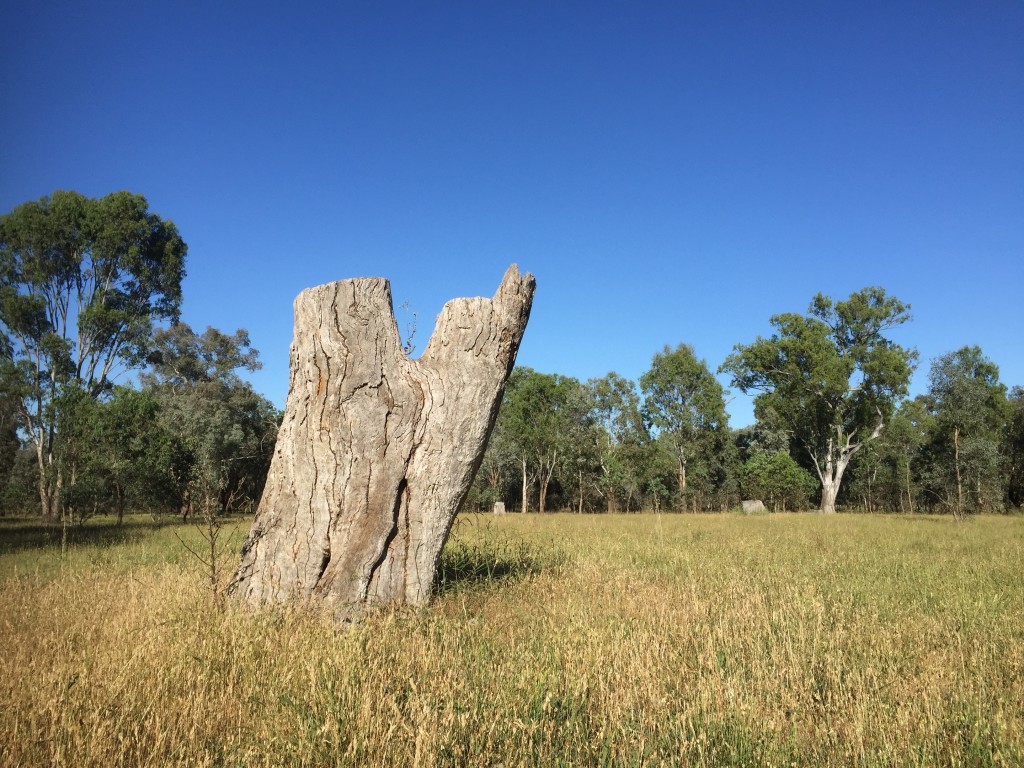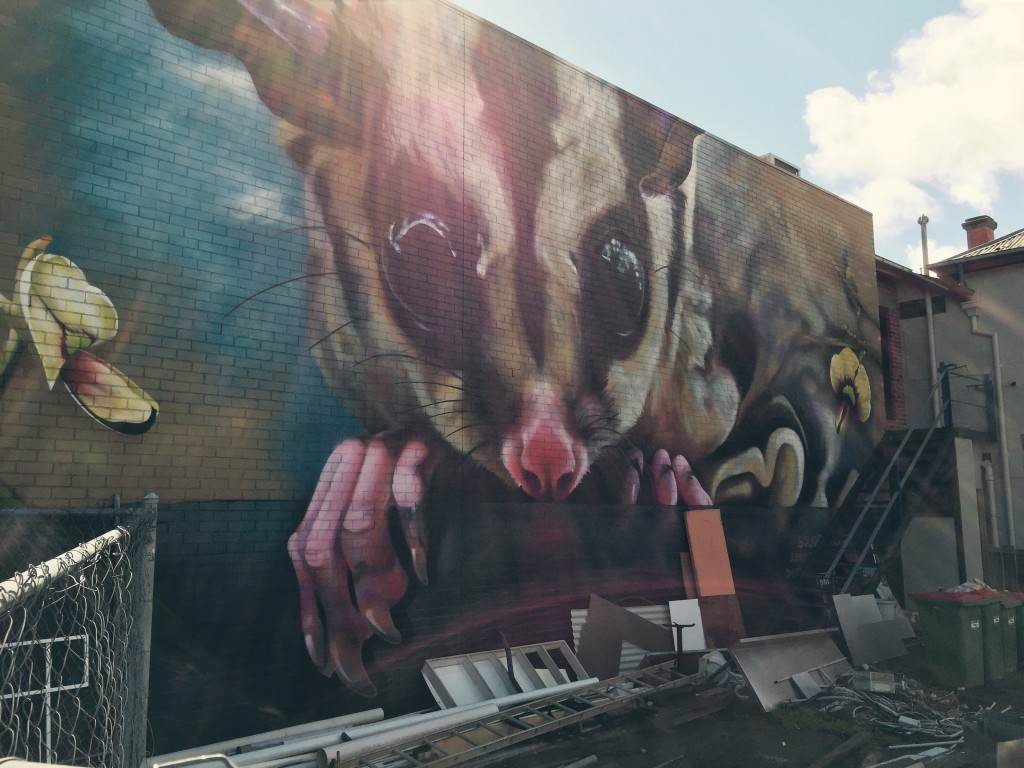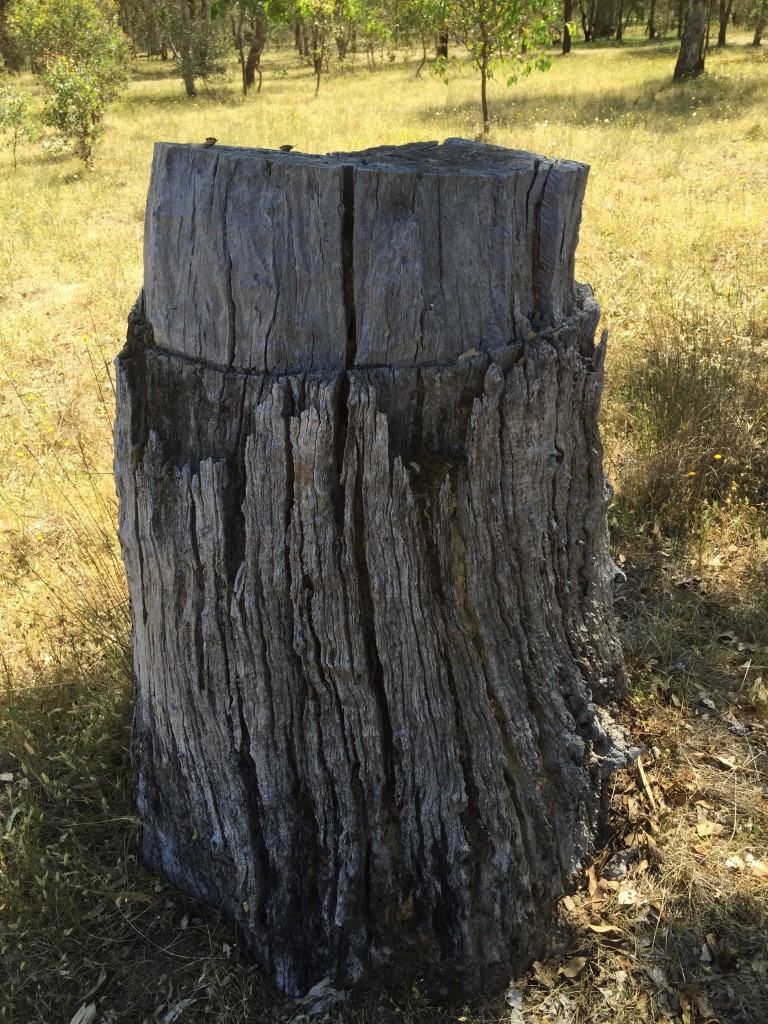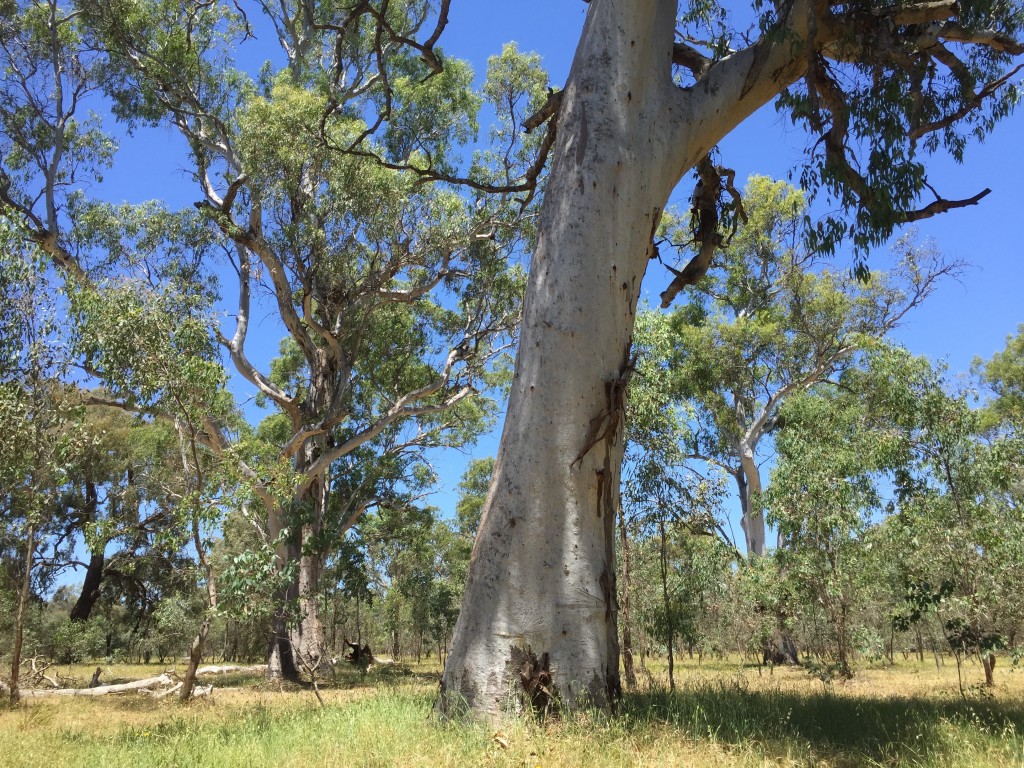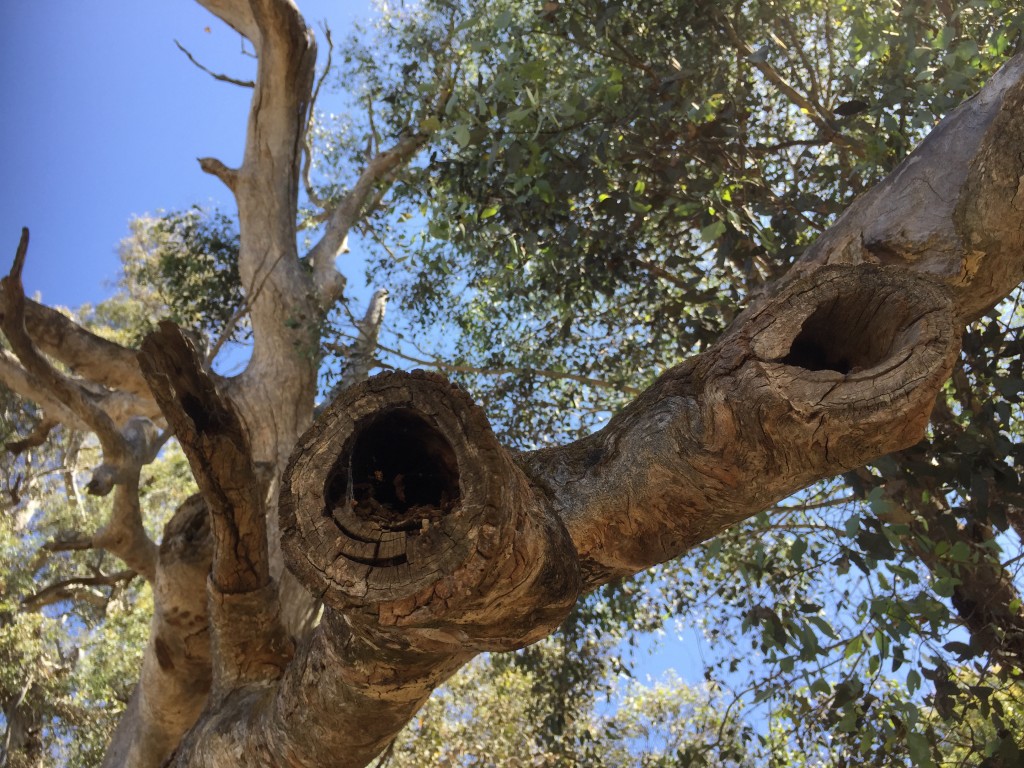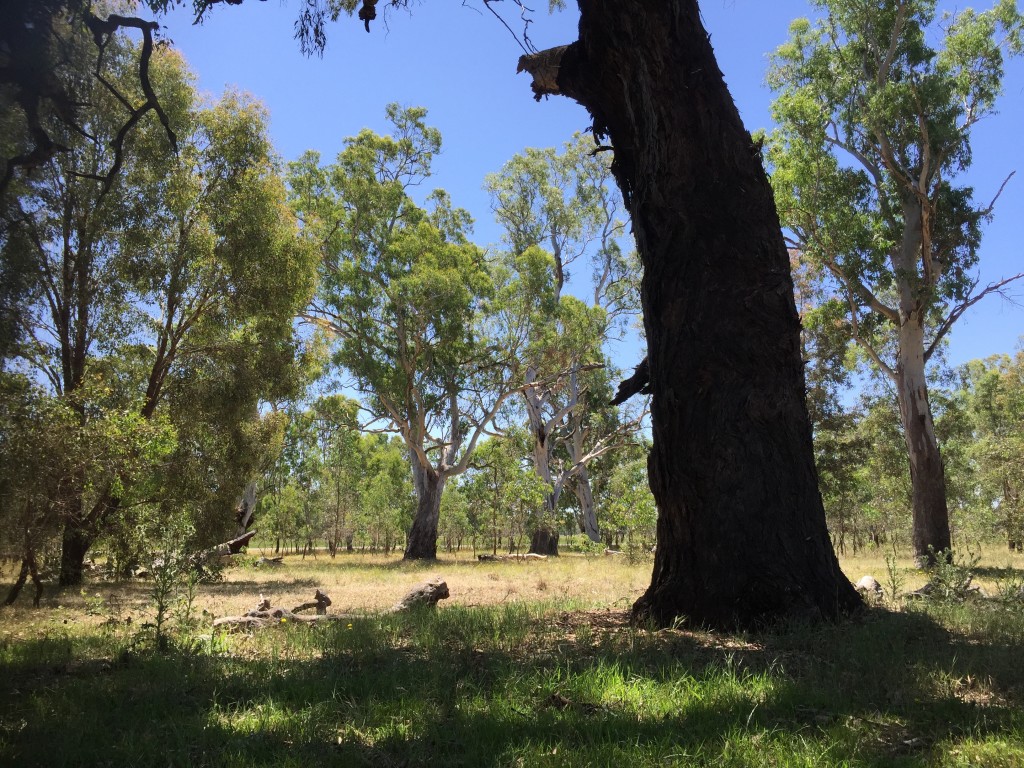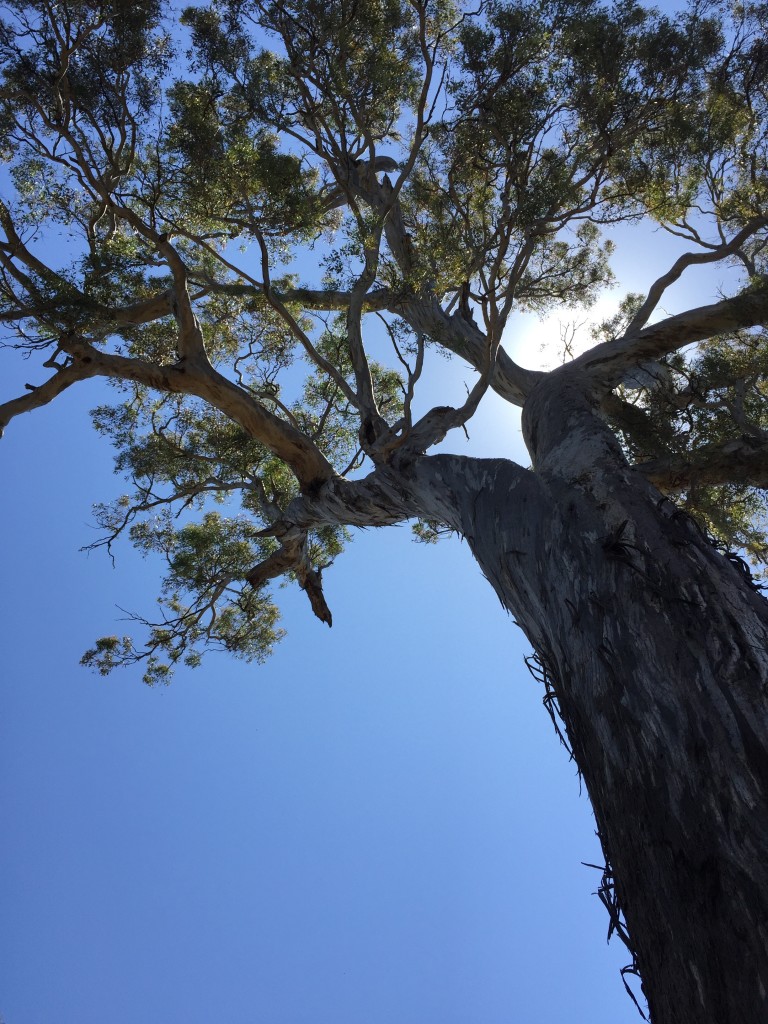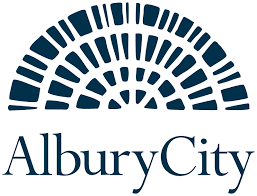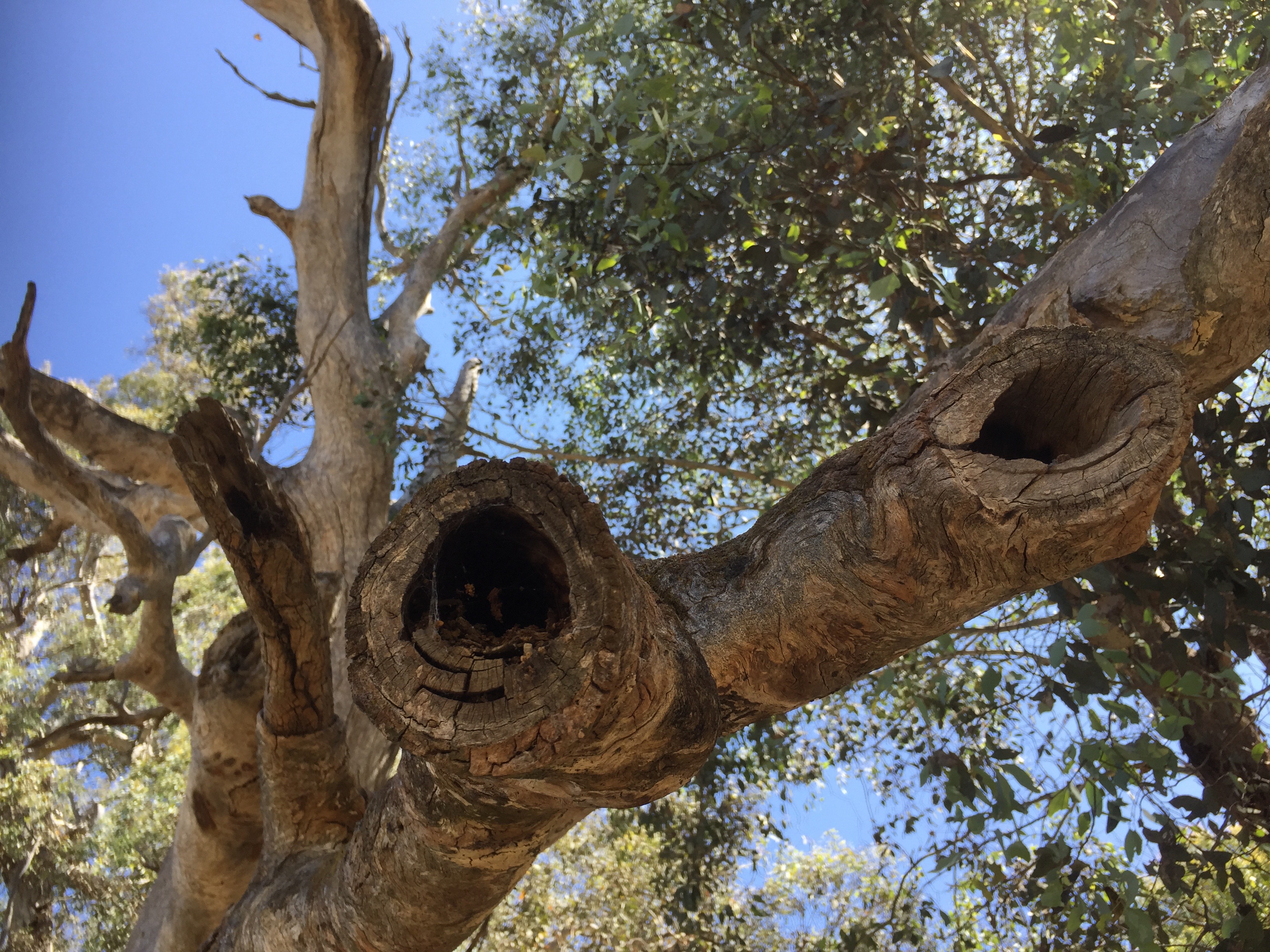
Hollow bearing tree at Bell’s TSR Thurgoona, NSW
SUMMARY
Between July 2015 and February 2018, Albury Conservation Company located and mapped hollow-bearing trees (HBTs) throughout Thurgoona/ Wirlinga, the major urban growth area of Albury, NSW. The project was funded by the NSW Government’s Environmental Trust.
A total of 523 hollow-bearing trees were located and mapped during the project. This data set significant adds to the records of 135 HBTs that were mapped at Charles Sturt University and Thurgoona Country Club Resort in 2012 and 2013, activities initiated and funded by Albury Conservation Company. 750 hectares of land have been mapped in the project, including 35 km of roadsides.
The HBT data and photos collected have been supplied to Albury City Council for the establishment of a significant tree overlay on their internal mapping software. The data is utilised by Planning and Environment staff when assessing Development Applications (DAs), and during the planning of infrastructure (e.g. new road construction). Consultants working on behalf of developers also have access to this data.
KEY RESULTS / FINDINGS
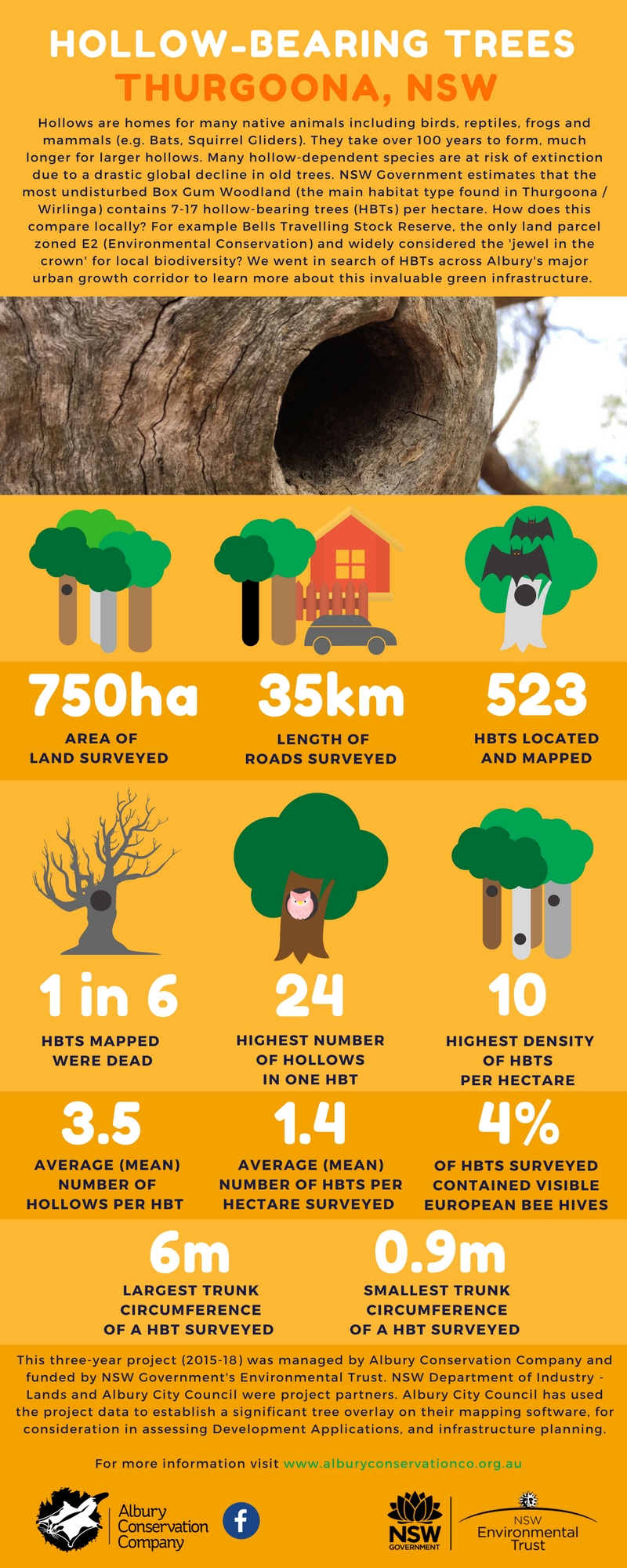
- 523 Hollow-bearing trees (HBTs) have been located and mapped across Thurgoona/ Wirlinga, by Albury Conservation Company and supported by NSW Department of Industry – Lands. Information has been captured using ground-based surveys with binoculars, and relates to species, number of hollows, diameter at breast height (DBH), and noting whether the tree is alive or dead. Many have also been photographed as a visual record.
- A Hollow-bearing tree (HBT) mapping overlay has been created by Albury City Council using the data provided by Albury Conservation Company. The overlay, on Council’s weave mapping software, is available for easy reference by Council’s Environment and Planning staff.
- HBTs have been mapped at the following locations:
- Bell’s Travelling Stock Reserve (30 hectares to date – north east section)
- Table Top Rd (Riverina Hwy to Old Sydney Rd)
- Williams Rd
- Wignell Rd
- Thurgoona Drive (east of Table Top Rd)
- Kerr Rd
- Hawksview Rd
- Knobel Rd
- Ettamogah Rd (between Table Top Rd and Elizabeth Mitchell Drive)
- Forest Drive
- Pickworth St
- Riverina Hwy (between Table Top Rd and Kerr’s Rd
- Private property at Riverina Hwy/Table Top Rd
- Corry’s Rd (west of Elizabeth Mitchell Drive)
- Elizabeth Mitchell Drive (between Riverina Highway and Ettamogah Rd)
- Woolshed Creek (between Vaughan Rd and east of Kerr rd)
- Eight Mile Creek
- Corry’s woodland
- Bishops Walk Park
- E3 Land at the corner of Tabletop Rd and Thurgoona Drive
- Thurgoona / Wirlinga has a drastic shortage of hollow-bearing trees. In relatively undisturbed woodland, the expected number of HBTs per hectare is between 7 and 17. [1] Albury Conservation Company has found that the highest density in Thurgoona / Wirlinga is 3.5 HBTs per hectare, which was found in Bell’s TSR and a small section of Corry’s Woodland. This is unsurprising given that Bell’s TSR is the only E2 (Environmental Protection) zoned land in the study area. Woolshed Creek and Eight Mile Creek, between Table Top Rd and Kerr Rd, contain on average just under 2 HBT’s per hectare.
- The study highlights the importance of retaining as many of the remaining hollow-bearing trees that we can, and that includes hollow-bearing trees found on land zoned for residential and commercial development.
[1] http://www.environment.nsw.gov.au/determinations/lossofhollowtreesktp.htm
In February 2018, the project culminated in a workshop targeting the local development industry, and hosted by Albury Conservation Company in partnership with Albury City Council and NSW Department of Industry – Lands. The workshop’s theme was hollow-bearing trees (HBTs) – their local distribution and characteristics, and their management in a landscape becoming increasingly urbanised.
24 people attended the event, including representatives from six of Albury /Wodonga’s major development consulting firms – Eslers Land Consulting, Spiire, Habitat Planning, Development Outcomes, Blueprint Planning, and SJE consulting. Also attending were Dr Amanda Cohn (Deputy Mayor Albury), and a number of staff from Albury City Council and NSW Department of Industry – Lands.
The group received presentations about hollow-bearing trees and their management from three speakers. To view the workshop presentations click on the links below:
- Rethinking ecological opportunities in an urban world – Dr Darren Le Roux (Environmental Projects Officer, ACT Government)
- Hollow-bearing trees in Thurgoona / Wirlinga: Project findings – Sam Niedra (Executive Officer, Albury Conservation Company)
- Hollow Bearing Trees in AlburyCity and an overview of the NSW Biodiversity Legislation Changes and their Impacts on AlburyCity’s Biocertification – Rebecca Redman (Environmental Planner Albury City Council)
BACKGROUND
In July 2015, Albury Conservation Company (ACC) commenced an exciting and innovative project focussing on hollow-bearing trees, arguably the most important natural asset in the Thurgoona / Wirlinga landscape.
ACC gratefully received $54,560 from the NSW Government’s Environmental Trust (Education Stream) to deliver the two-year project.
The project, entitled Urban Developers constructing a hollow future for Albury’s wildlife, aims to increase retention of hollow-bearing trees (HBTs) in Thurgoona/Wirlinga through collaboration with key stakeholders involved in the urban development process, including Albury City Council.
The project will achieve its aims through implementing the following activities:
- Survey and Map HBTs in Thurgoona/Wirlinga in partnership with key stakeholders and community groups
- Establish a HBT Working Group involving key development stakeholders (e.g. Albury City Council) to exchange information regarding HBT distribution, conservation values, threats, and opportunities to increase retention rates
- Conduct training events for working group members to exchange information and promote increased protection of HBTs
- Host a pilot Awards Program recognising local best practice in HBT retention
PROJECT RATIONALE
Naturally occurring tree hollows are vital for the survival of many wildlife species, providing homes for 1 in 4 native vertebrate animals. In NSW alone, species reliant on tree hollows for shelter and nests include at least 46 mammals, 81 birds, 31 reptiles and 16 frogs (Gibbons and Lindenmayer 1997, Gibbons and Lindenmayer 2002). Of these, 40 species are listed as threatened under the NSW Threatened Species Conservation (TSC) Act 1995. Loss of hollow-bearing trees is listed as one of the 36 key threatening processes under the TSC Act.
In Thurgoona / Wirlinga hollows are a valuable habitat resource for Squirrel Gliders, woodland birds, bats, reptiles, and other fauna. Currently there is minimal documentation regarding their distribution, attributes, and utilisation by fauna. Recording and monitoring hollowing-bearing trees will be an important first step in helping to conserve this valuable resource and to improve biodiversity management in surrounding areas.
Tree hollows take a very long time to develop. Sadly, they can be taken from a landscape in an afternoon. Eucalypts, or ‘gum trees’, are the main source of hollows in Australia, as is the case in Thurgoona / Wirlinga. Hollow formation in Eucalypts generally take 120-180 years to produce hollows of sufficient size to house mammals (Gibbons & Lindenmayer, 2002), such as the threatened Squirrel Glider.
The protection of hollow-bearing trees in the Thurgoona / Wirlinga area will be essential if the community is to ensure that we maintain viable populations of many local threatened species, including the Squirrel Glider, well into the future.
PROJECT METHODOLOGY
Trees are being assessed from the ground using binoculars, and the following information is being collected:
- GPS co-ordinates
- elevation
- tree species
- number of hollows
- diameter at breast height (1.3 m above ground)
- whether the tree is alive or dead
- presence of European bees
- photo of tree
The tree is walked around and observed from as many angles as possible. A tree is recorded as bearing hollows only if an actual hole is observed. Potential hollows facing upwards are not recorded. Each tree generally takes 10 minutes to observe and capture data.
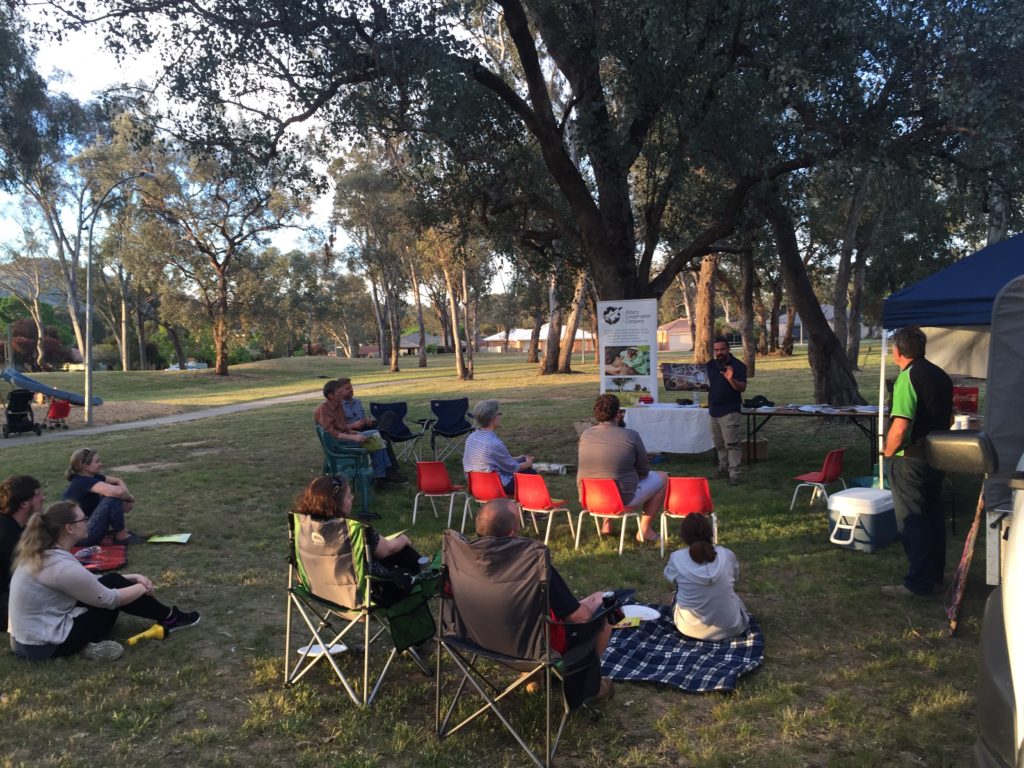
Dr Damian Michael presenting at ‘Holloween’, a community event in Thurgoona sharing results from the hollow-bearing tree project and conducting a search for hollow-dependent fauna (10/11/2017).
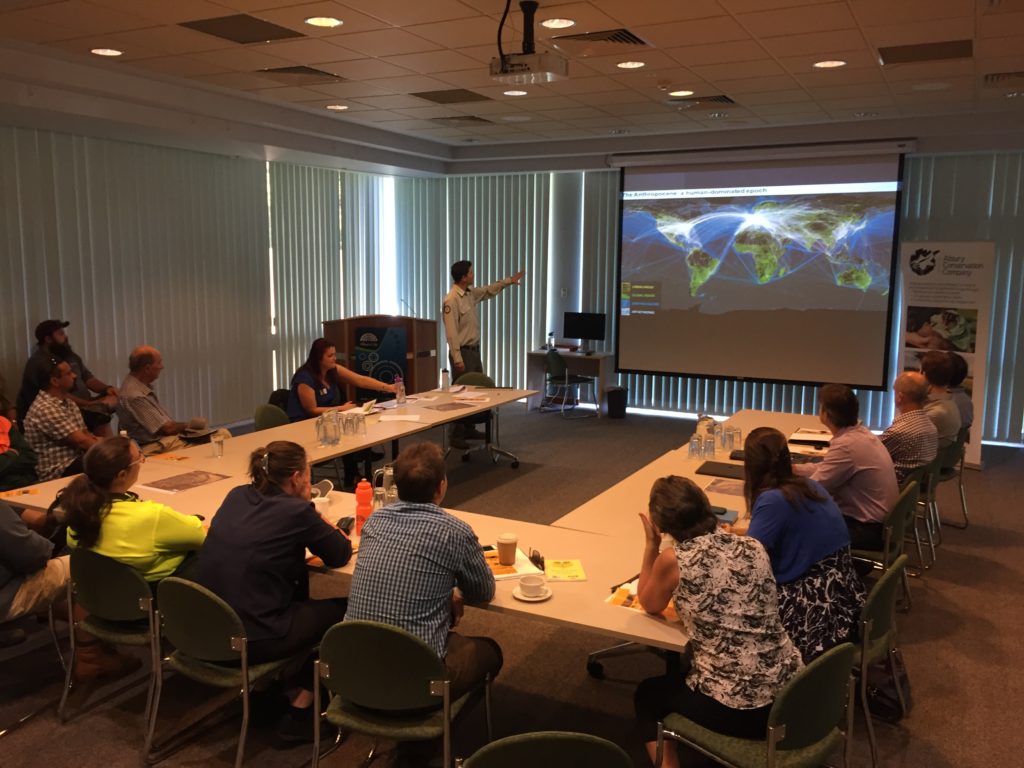
Hollow-bearing Tree (HBT) Workshop, Albury – Presentation by Dr Darren Le Roux (ACT Government) on managing old trees in urban growth areas of Canberra.
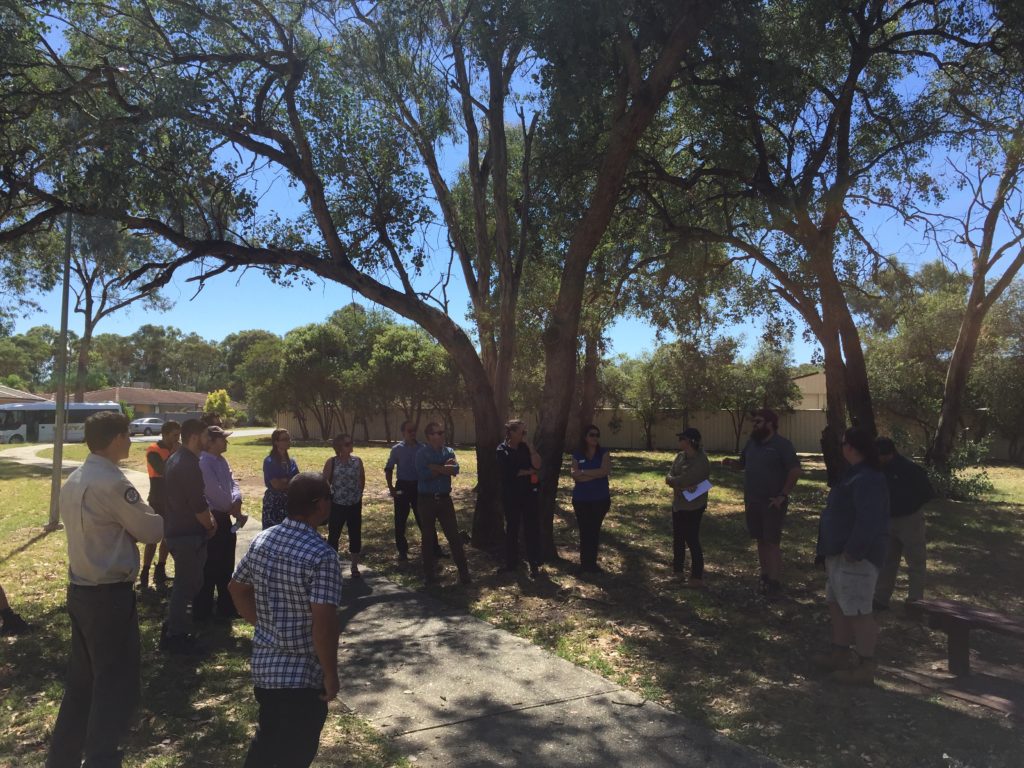
Hollow-bearing Tree (HBT) workshop, Albury – site visits around Thurgoona / Wirlinga including Bishop’s Walk Park.
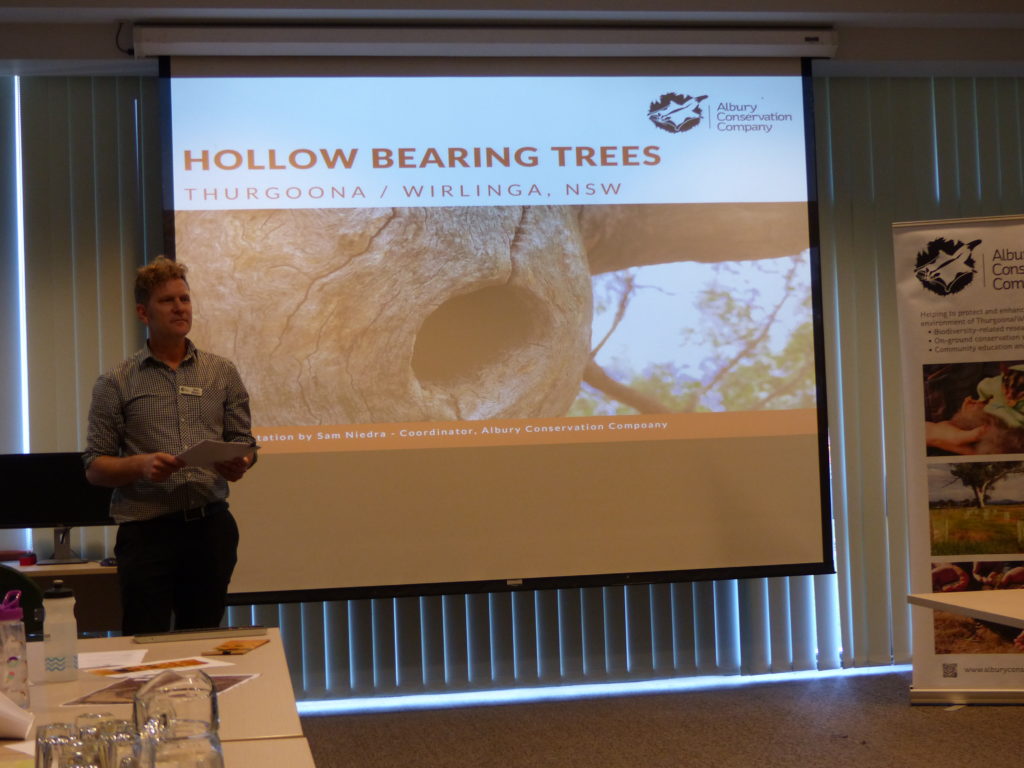
Hollow-bearing Tree (HBT) Workshop, Albury – presentation on project findings by Sam Niedra (Coordinator, Albury Conservation Company)
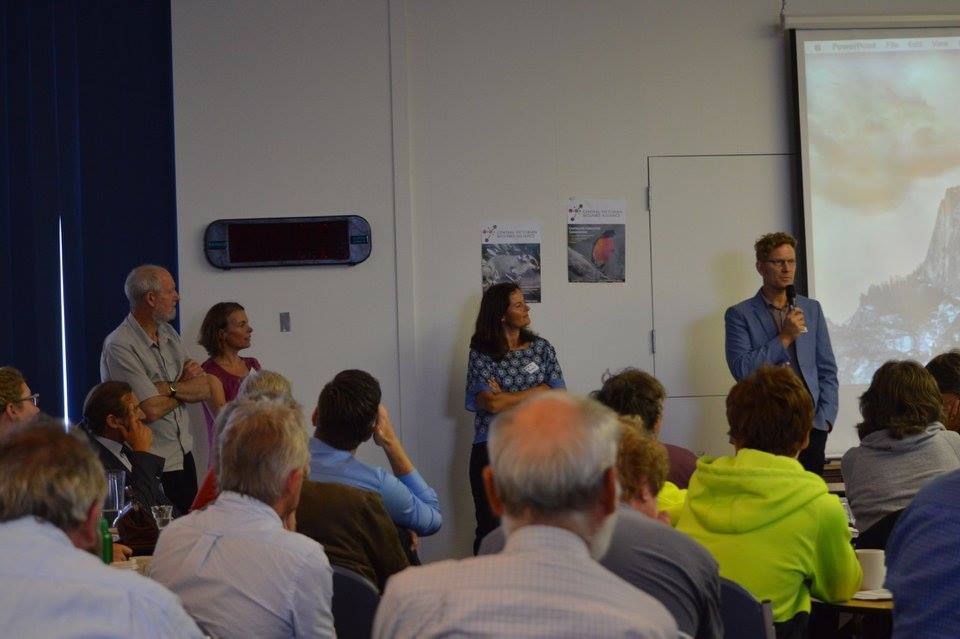
Albury Conservation Company coordinator Sam Niedra discussing the Hollow-bearing Tree Project at the ‘Glider Symposium’, hosted by the Central Victorian Biolinks Alliance (18 March 2016)
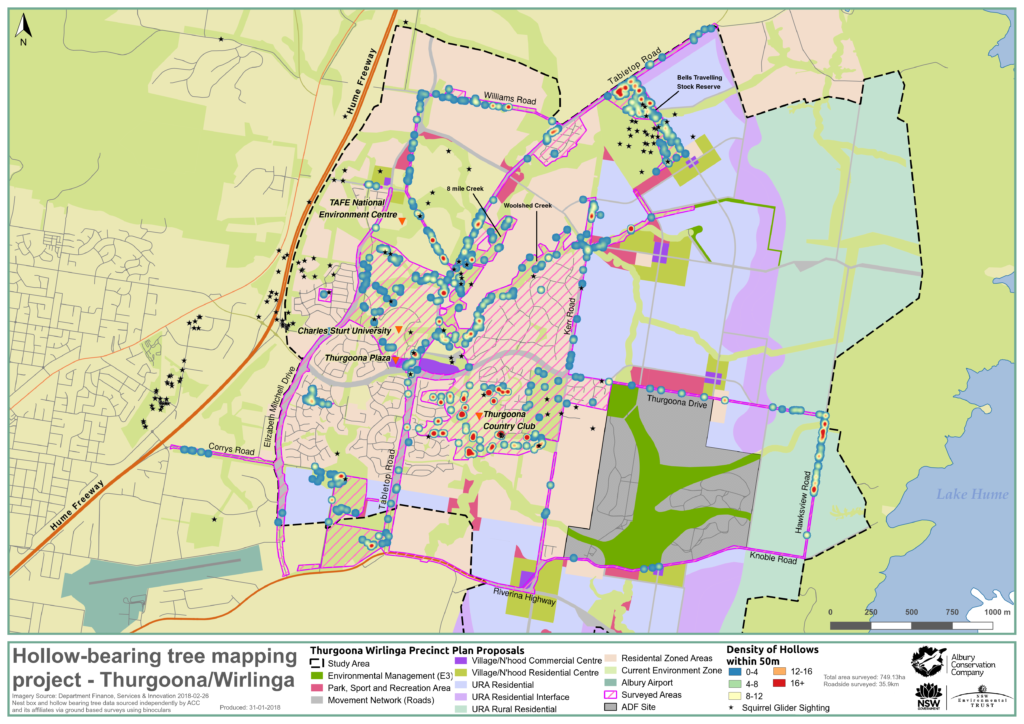
Overview map of the Hollow bearing tree project in Thurgoona Wirlinga (Albury Conservation Company, 31Jan2018)
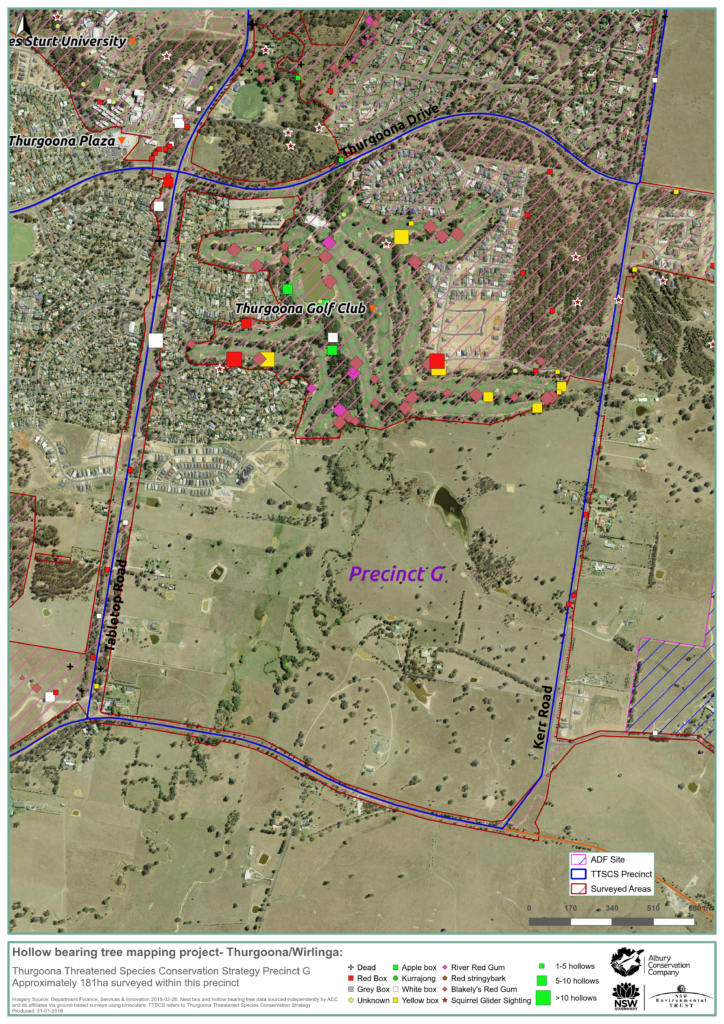
Map of Hollow-bearing Trees (HBTs) recorded in Precinct G of the Thurgoona Threatened Species Conservation Strategy (Albury Conservation Company, 31Jan2018)
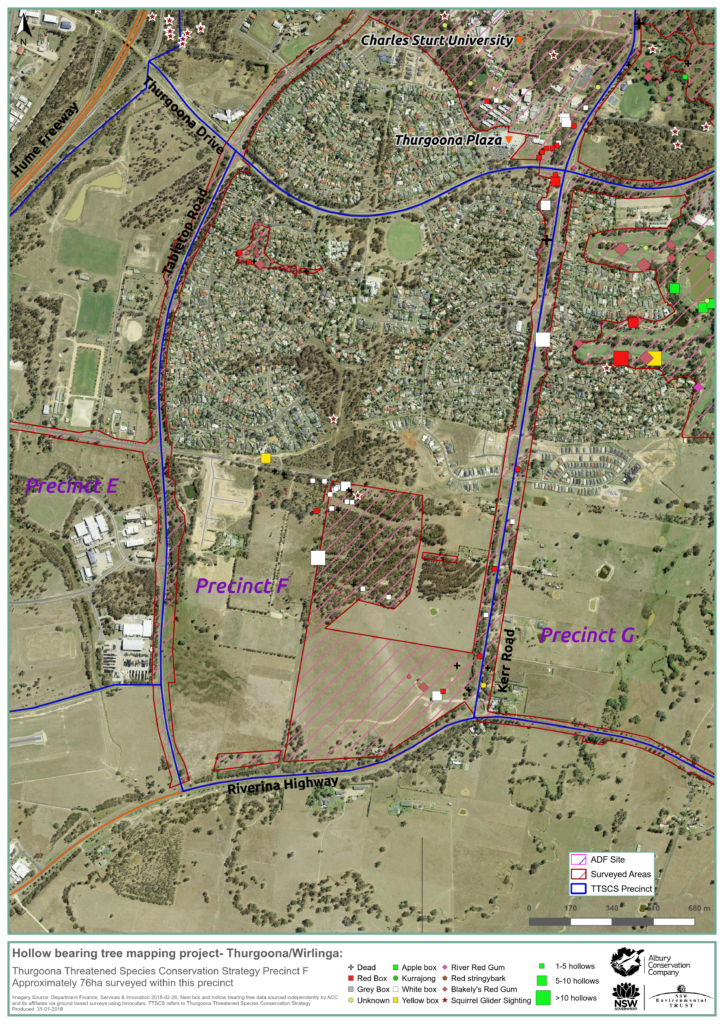
Map of Hollow-bearing Trees (HBTs) recorded in Precinct F of the Thurgoona Threatened Species Conservation Strategy (Albury Conservation Company, 31Jan2018)
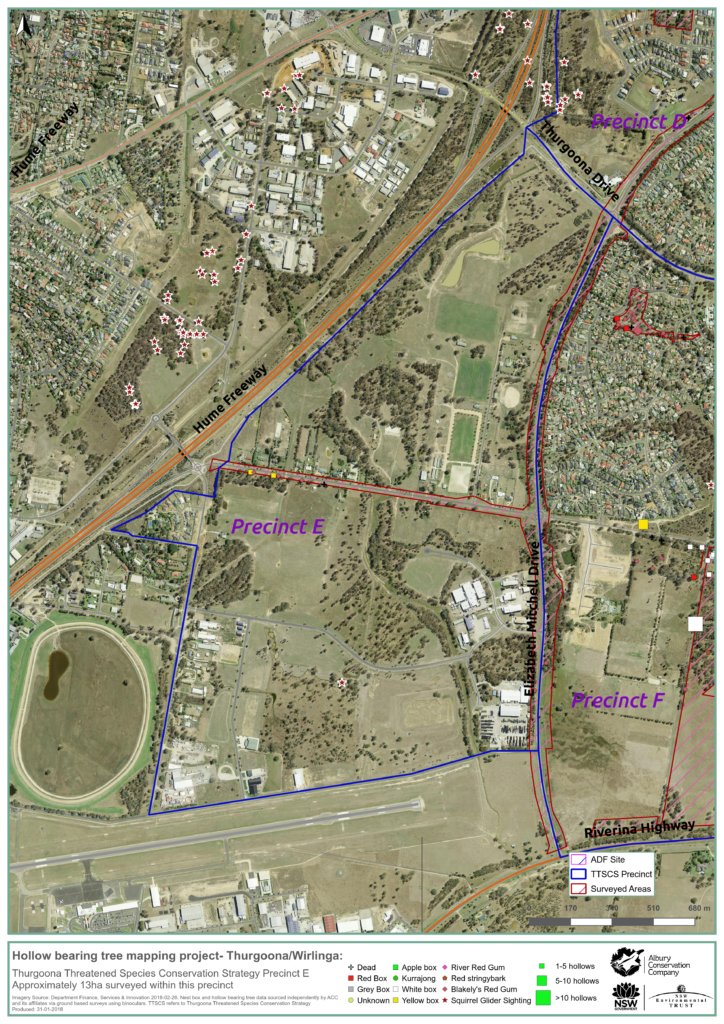
Map of Hollow-bearing Trees (HBTs) recorded in Precinct E of the Thurgoona Threatened Species Conservation Strategy (Albury Conservation Company, 31Jan2018)
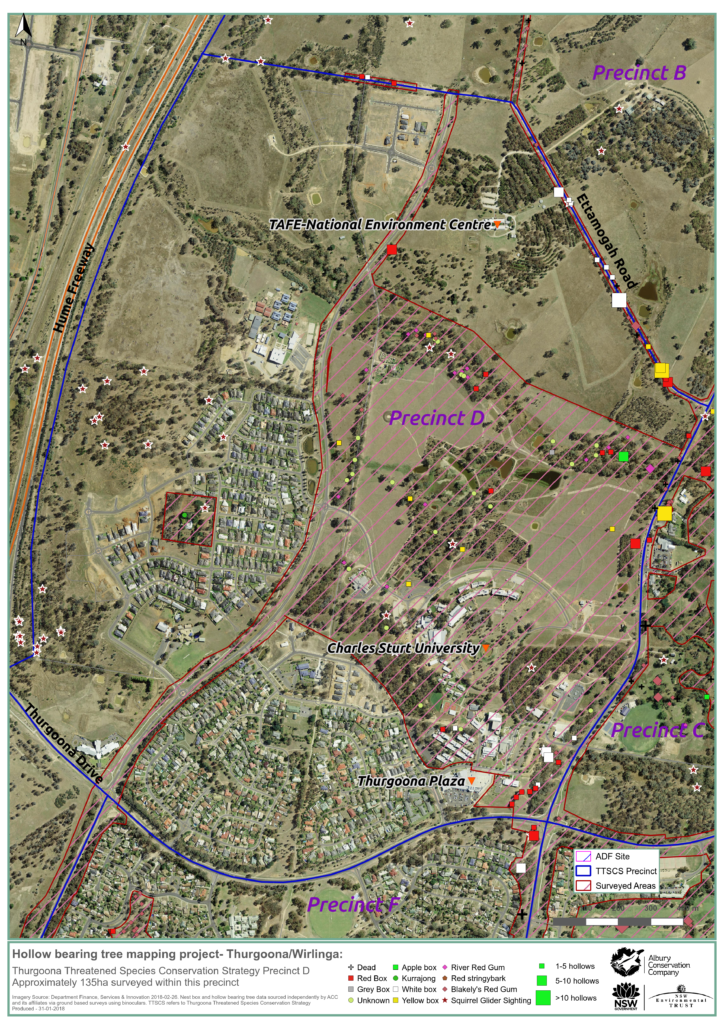
Map of Hollow-bearing Trees (HBTs) recorded in Precinct D of the Thurgoona Threatened Species Conservation Strategy (Albury Conservation Company, 31Jan2018)
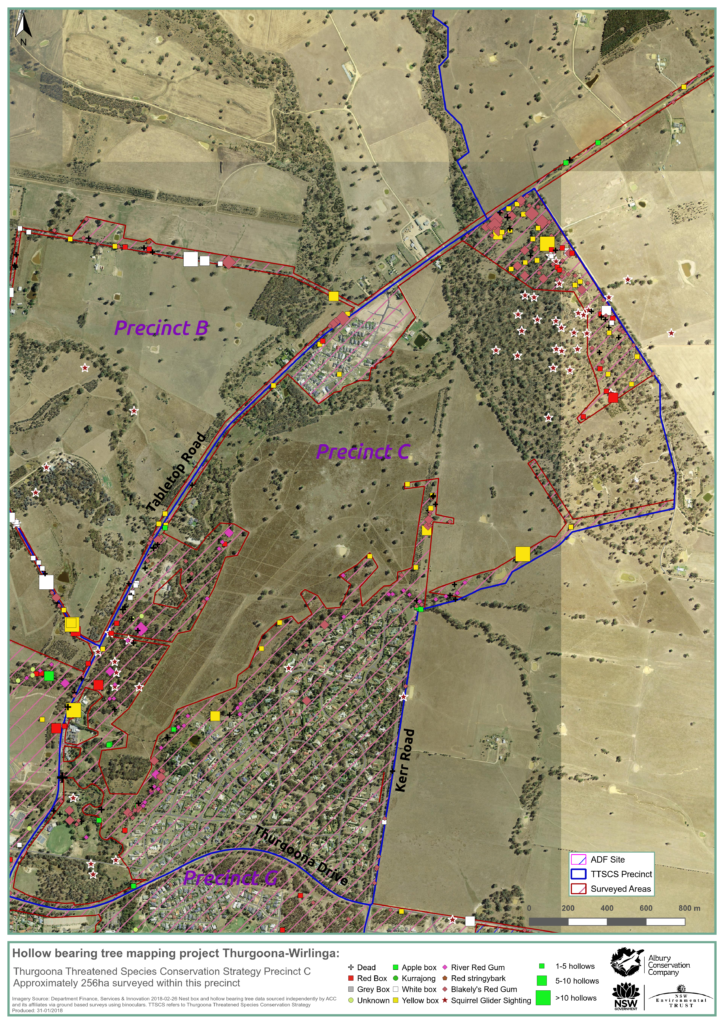
Map of Hollow-bearing Trees (HBTs) recorded in Precinct C of the Thurgoona Threatened Species Conservation Strategy (Albury Conservation Company, 31Jan2018)
For more information click here or contact the Albury Conservation Company via:
M: 0447 183 747 (Sam Niedra)
FUNDING

